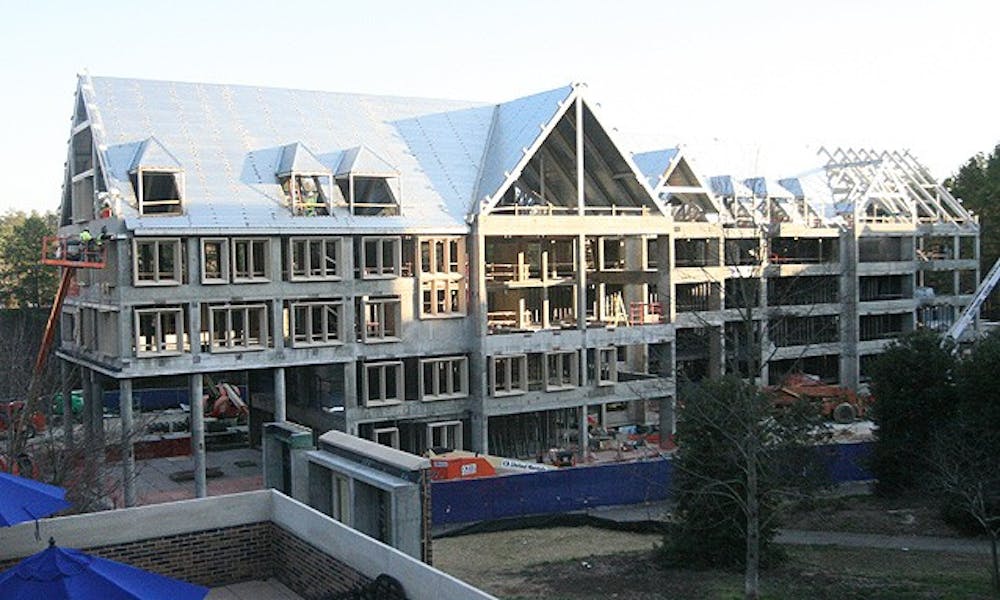The house model may be new to Duke, but it’s not uncharted territory for some peer institutions.
Undergraduates at schools such as Harvard University, Yale University and Washington University in St. Louis have residential models somewhat similar to the house model Duke will implement in Fall 2012. Administrators involved in developing Duke’s house model, however, said the model will take a distinctly different approach from peer schools to achieve Duke’s goals of equity and community.
“Ours is a Duke model and it’s really quite unique,” said Joe Gonzalez, associate dean for residence life. “Part of transitioning to smaller communities is... for communities to be elevated and stronger. With [measures like] the right to return, we’re going to offer to all students what only some students experience now.”
And though the Duke house model and residential college models at other universities are similar in that they allow small groups of students from different years to live together, Gonzalez said the biggest differences between Duke’s strategy and the policies of places like Harvard and Yale are the smaller size of houses at Duke and a lesser role for faculty.
Gonzalez noted that although the administration wants faculty to have “significant involvement,” there is no desire to have live-in faculty.
The average size of a Duke house will be about 40 students, he said, smaller than the average population of a residential college at Yale, which ranges between 400 and 500 students. A smaller number of students in each house, however, means a greater number of houses across West and Central campuses.
“We expect these houses to ‘ground’ upper-class Duke students in diverse communities that feel like home, especially since they can return year after year,” Donna Lisker, associate dean of undergraduate education, wrote in a Feb. 22 e-mail.
As The Chronicle previously reported, the house model will likely feature 70 houses—a large number that has sparked some concern from students, Gonzalez said. He noted that these smaller communities will be strongly encouraged to interact and collaborate through residential programming and initiatives. It is possible, however, that there will be fewer than 70 communities.
“It is a lot of individual communities,” Gonzalez said. “But we’re convinced of two things: smaller communities mean stronger communities... and that house councils will provide a lot of opportunity for interaction. Houses will not be limited solely by their internal community.”
Steve Nowicki, dean and vice provost for undergraduate education, said the small houses accurately reflect what alumni enjoyed about the house model through the 1970s and 1980s. He added that Duke’s architecture lends itself to small house sizes.
“I think those small communities [will be] more real communities,” he said. “If your house is 50 people, then it’s easy to know who they all are—there’s a familiarity. There is some cultural anthropology in thinking about this: What is a good size for having a community organically spring up.”
Nowicki also added that the Duke house model demonstrates the University’s ingenuity as an institution distinct from its peers.
“I would quickly say that I want Duke to be Duke,” he said. “It’s really not similar in other ways... to what the Ivies are doing. Our understanding is that these smaller communities are the way to go. If I wanted something else, I would go to Harvard.”
Vice President for Student Affairs Larry Moneta agreed with Nowicki that Duke’s house model will be distinct from the typical residential college model, or Harvard’s house system which features 12 houses.
“On campuses where their ‘house’ is much larger, they may emphasize floors and wings within the house as the smaller community with which students identify,” Moneta wrote in a Feb. 22 e-mail. “We’re going right to the ‘living community’ per se by labeling the collection of spaces and students who will self-govern and interact as our ‘house.’”
There is at least one thing in common between Duke’s house model and the systems at peer institutions: all promote community and inclusion.
Mary Elliot, associate director of residential life at Washington University in St. Louis—which implemented a residential college system in 1998—said the system’s contribution to the campus community and student experience is remarkable.
“I love it,” she said. “I think its indicative of what we really want our students to experience: a great sense of community on campus [and having] some place where they belong. I really believe they come into the residential colleges and the second they step on campus, they feel they have entered their own little community within the WashU community.”
Get The Chronicle straight to your inbox
Signup for our weekly newsletter. Cancel at any time.

